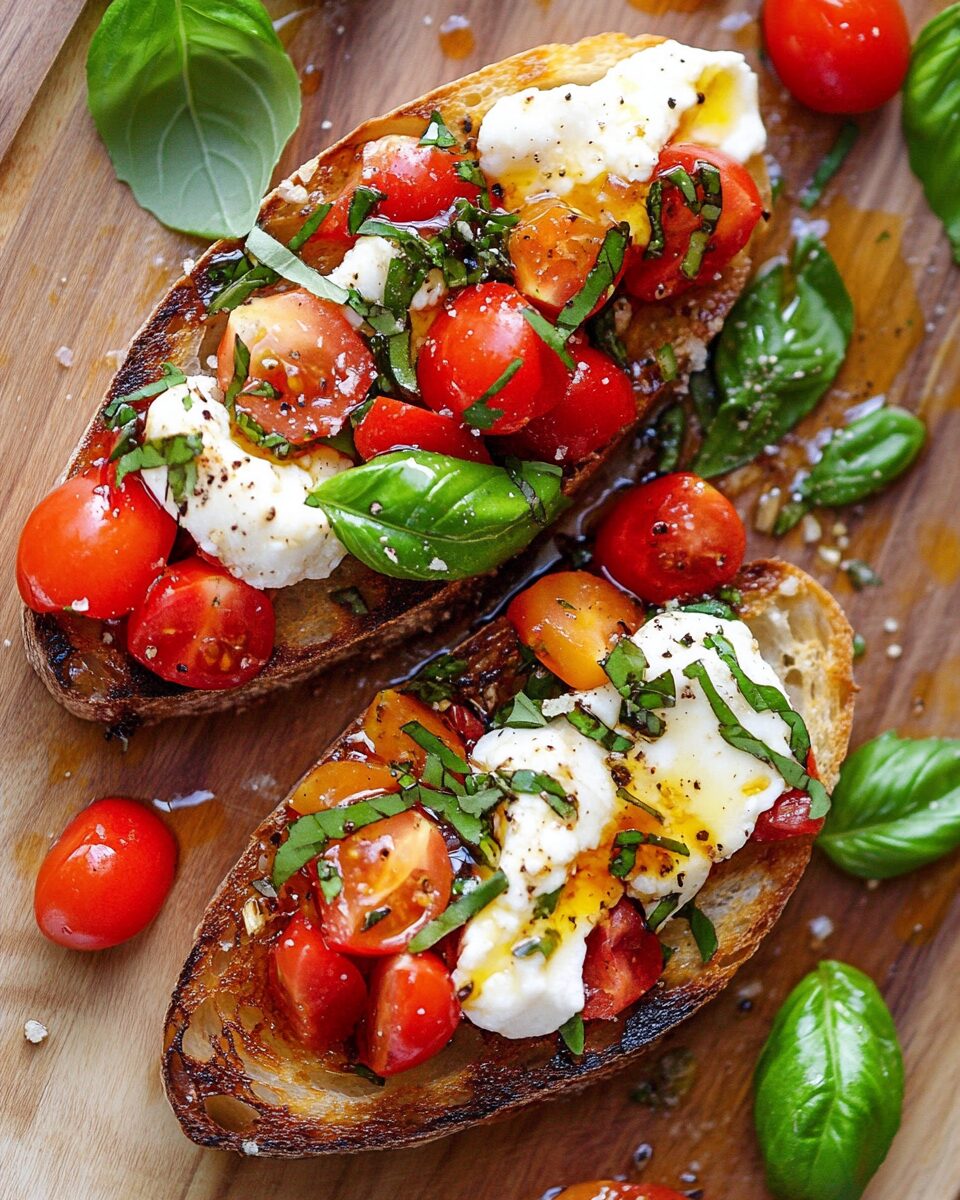Burrata Bruschetta is the perfect combination of creamy burrata cheese, fresh tomatoes, and fragrant basil all served on crispy, garlic-rubbed toast. It’s the ultimate summer appetizer, balancing richness and freshness in every bite.
This easy-to-make dish comes together in just minutes, making it ideal for last-minute gatherings or a light snack. Whether you’re hosting a summer get-together or enjoying a quiet evening at home, Burrata Bruschetta is sure to impress.
Full Recipe:
- 1 loaf of crusty bread (like ciabatta or baguette), sliced
- 2 garlic cloves, halved
- 1 ball of fresh burrata cheese
- 1 pint cherry tomatoes, halved
- Fresh basil leaves, torn
- Extra virgin olive oil, for drizzling
- Balsamic glaze, for drizzling
- Salt and pepper, to taste
Directions:
- Preheat the oven to 400°F (200°C).
- Arrange the sliced bread on a baking sheet and drizzle with olive oil.
- Toast the bread in the oven for 5-7 minutes, until golden and crisp.
- Remove the bread from the oven and rub each slice with the cut side of the garlic cloves.
- Tear the burrata and distribute it evenly over the toasted bread slices.
- Top with halved cherry tomatoes and torn basil leaves.
- Drizzle with extra virgin olive oil and balsamic glaze.
- Season with salt and pepper to taste. Serve immediately.
Prep Time: 10 minutes | Cooking Time: 7 minutes | Total Time: 17 minutes
Kcal: 220 kcal per serving | Servings: 4 servings
What is Burrata Bruschetta?
Burrata Bruschetta is a simple yet elegant Italian-inspired appetizer that combines rich, creamy burrata cheese with fresh, vibrant tomatoes and fragrant basil on crispy garlic-rubbed toasts. This dish is a delightful variation of traditional bruschetta, with the burrata adding an extra level of indulgence. Burrata, a fresh Italian cheese made from mozzarella and cream, has a soft, buttery center that pairs beautifully with the tangy sweetness of tomatoes and the herbaceous flavor of fresh basil.
The Origin of Bruschetta
Bruschetta has its roots in Italian cuisine, specifically from the regions of Tuscany, Umbria, and Lazio. Traditionally, it consists of grilled bread rubbed with garlic and topped with olive oil, salt, and sometimes vegetables or cured meats. The name “bruschetta” comes from the Italian verb bruscare, meaning “to roast over coals.” The addition of toppings like tomatoes, mozzarella, and now burrata, has made bruschetta a popular appetizer worldwide, enjoyed in various forms.
Why Burrata?
While mozzarella is often used in classic bruschetta, burrata offers a creamier, more luxurious texture that elevates this dish. The outer layer of burrata is made from mozzarella, while the inside is filled with stracciatella and cream, making it rich and flavorful. When combined with the juicy tomatoes and crispy bread, burrata adds a unique contrast in texture, making each bite incredibly satisfying.
Health Benefits of Burrata Bruschetta
Though indulgent, Burrata Bruschetta can be part of a balanced diet. Here are some health benefits:
- Rich in Calcium and Protein: Burrata, being a cheese, provides a good source of calcium and protein, which are essential for bone health and muscle repair.
- Antioxidants from Tomatoes: Tomatoes are rich in lycopene, an antioxidant that supports heart health and protects the skin from sun damage.
- Healthy Fats from Olive Oil: The use of extra virgin olive oil provides healthy monounsaturated fats, known for their cardiovascular benefits.
Perfect Pairings for Burrata Bruschetta
To enhance the flavors of Burrata Bruschetta, consider pairing it with:
- White Wines: A crisp Sauvignon Blanc or a light Pinot Grigio complements the creaminess of the burrata while balancing the acidity of the tomatoes.
- Sparkling Water or Lemonade: For a non-alcoholic option, sparkling water with a splash of lemon adds a refreshing twist to the richness of the appetizer.
- Salads: Serve Burrata Bruschetta with a light green salad or arugula dressed with balsamic vinaigrette for a complete meal.
Tips for Making the Perfect Burrata Bruschetta
- Use Fresh Ingredients: Since this is a simple dish, the quality of the ingredients really shines through. Opt for fresh, ripe tomatoes, fragrant basil, and a good-quality burrata.
- Serve Immediately: Burrata is best served fresh, so assemble the bruschetta just before serving to ensure the bread stays crisp and the cheese remains creamy.
- Balsamic Glaze: A drizzle of balsamic glaze adds a sweet and tangy element that balances the creaminess of the burrata and the acidity of the tomatoes. You can easily make your own balsamic reduction by simmering balsamic vinegar until thickened or use a store-bought version.
Ideal Occasions for Serving Burrata Bruschetta
Burrata Bruschetta is a versatile dish that can be served on various occasions:
- Summer Parties: Its fresh, vibrant flavors make it an excellent choice for outdoor gatherings or summer BBQs.
- Dinner Parties: Impress your guests with this elegant appetizer that looks as stunning as it tastes.
- Casual Weeknight Meals: If you’re looking for a quick yet delicious meal, Burrata Bruschetta is perfect for a light dinner or snack.
How to Choose the Best Ingredients for Burrata Bruschetta
The success of a simple dish like Burrata Bruschetta largely depends on the quality of its ingredients. Since this recipe has minimal components, every element should be fresh and high-quality.
- Bread: The foundation of bruschetta is the bread, so choosing the right type is crucial. A crusty, artisanal loaf such as ciabatta, sourdough, or baguette works best. The bread needs to be sturdy enough to hold the toppings without becoming soggy. Ideally, the bread should have a good chew with an airy interior that crisps up well under heat.
- Burrata Cheese: Burrata is a delicate cheese, and freshness is key. Look for burrata that is still firm on the outside and soft on the inside. When you cut into it, the creamy center should ooze out. Burrata can typically be found at specialty grocery stores or Italian markets. If burrata isn’t available, fresh mozzarella or stracciatella can serve as an alternative, though they won’t have the same richness.
- Tomatoes: Since this dish is especially popular during the summer, it’s important to use ripe, in-season tomatoes. Cherry or grape tomatoes work particularly well because they are naturally sweet and juicy. If larger tomatoes are more accessible, you can dice them into small pieces. Heirloom tomatoes are another excellent option, offering vibrant colors and an extra depth of flavor.
- Basil: Fresh basil leaves are essential in this recipe. Basil has a sweet, slightly peppery flavor that pairs beautifully with burrata and tomatoes. To avoid bruising the delicate basil leaves, tear them by hand rather than chopping them with a knife.
- Olive Oil and Balsamic Glaze: A high-quality extra virgin olive oil is ideal for drizzling over the bruschetta. Its peppery and fruity notes complement the cheese and tomatoes. Balsamic glaze adds a touch of sweetness and acidity to balance the richness of the burrata. If you don’t have balsamic glaze, you can reduce regular balsamic vinegar by simmering it until it thickens into a syrupy consistency.
Creative Variations of Burrata Bruschetta
While the classic combination of burrata, tomatoes, and basil is hard to beat, you can easily get creative with your toppings. Here are some ideas to add variety to your Burrata Bruschetta:
- Seasonal Fruits: For a sweet-savory twist, try adding slices of peaches, figs, or strawberries. These fruits complement the creaminess of burrata beautifully, making this an exciting option for brunch or appetizers.
- Roasted Vegetables: In cooler months, swap out the fresh tomatoes for roasted vegetables like bell peppers, zucchini, or eggplant. Roasting enhances the natural sweetness of the vegetables, making for a comforting and flavorful bite.
- Pesto Drizzle: Instead of balsamic glaze, drizzle homemade or store-bought basil pesto over the top. Pesto adds a nutty, herbaceous flavor that enhances the freshness of the bruschetta.
- Prosciutto: For a meatier version, add slices of prosciutto or other cured meats on top of the burrata. The salty, savory notes from the prosciutto pair wonderfully with the creamy cheese and sweet tomatoes.
- Spicy Kick: If you enjoy a little heat, add a pinch of red pepper flakes or finely diced chili peppers over the bruschetta before serving. The spiciness will contrast nicely with the cool, creamy burrata.
Burrata Bruschetta: A Versatile Dish for Any Occasion
Burrata Bruschetta is a versatile dish that can fit into various dining settings. Here’s how you can incorporate it into different occasions:
- Elegant Appetizer for Dinner Parties: Burrata Bruschetta makes an impressive appetizer for formal dinner parties. Its visual appeal and gourmet flavor combination will set the tone for a sophisticated meal.
- Quick Snack or Light Lunch: With only a handful of ingredients and minimal prep time, this dish is perfect for a quick snack or light lunch. Pair it with a simple green salad for a complete meal.
- Brunch Favorite: Serve Burrata Bruschetta alongside other brunch favorites like avocado toast, frittatas, or fresh fruit platters. Its mix of creamy, crispy, and tangy elements makes it a perfect complement to a leisurely weekend brunch.
- Picnic Staple: Pack Burrata Bruschetta for a picnic. To keep the bread from getting soggy, bring the toasted bread, burrata, and toppings separately and assemble on-site for a fresh, delicious meal.
- Holiday Entertaining: Whether it’s a summer BBQ or a winter holiday gathering, Burrata Bruschetta can be adapted to suit any season. For winter, you can incorporate roasted squash or cranberries for a festive touch.
How to Store and Reheat Burrata Bruschetta
While Burrata Bruschetta is best served fresh, you can prepare parts of the dish ahead of time and store them for later use.
- Bread: Toast the bread ahead of time and store it in an airtight container at room temperature for up to a day. Reheat in a hot oven for a few minutes to restore crispiness before assembling the bruschetta.
- Tomatoes and Basil: Store the halved tomatoes in an airtight container in the refrigerator for up to 2 days. Basil should be used fresh, but if you need to store it, place the stems in a glass of water, cover the leaves loosely with a plastic bag, and refrigerate for up to 3 days.
- Burrata: Burrata should be eaten as fresh as possible. If you have leftovers, store them in their original container in the refrigerator for up to 2 days. Keep in mind that burrata loses its creamy texture the longer it sits.
Reheating Tip: If the toasted bread loses its crispiness, you can reheat it in the oven at 350°F (175°C) for a few minutes until it’s crispy again. However, it’s best to serve the bruschetta as soon as it’s assembled to maintain the freshness and texture of the ingredients.
Nutritional Information
For those keeping an eye on their diet, here’s an approximate breakdown of the nutrition found in a typical serving of Burrata Bruschetta:
- Calories: Around 220 kcal per serving (depending on the size of the bread and amount of burrata used)
- Carbohydrates: Roughly 24 grams
- Protein: 7 grams (mostly from burrata)
- Fats: 12 grams (from burrata and olive oil)
- Sodium: 300-400 mg (varies based on seasoning and cheese)
Conclusion
Burrata Bruschetta is a simple yet elegant dish that highlights the beauty of fresh ingredients. With its creamy burrata, juicy tomatoes, and crispy garlic-rubbed toast, it’s a perfect appetizer for any occasion. Versatile and easy to prepare, this dish can be customized with seasonal variations, making it a delightful addition to summer gatherings, dinner parties, or casual meals. Whether you’re a seasoned cook or just getting started, Burrata Bruschetta is a crowd-pleasing recipe that will impress with its flavor and presentation.






